Introduction to Digital Currencies and Monetary Policy
As the world of finance continues to evolve, the Bank of England (BoE) is taking a closer look at digital currencies. In a recent speech, chief economist Andy Haldane highlighted the transformative potential of these assets, suggesting they could lay the groundwork for a new monetary order. Yes, folks, hold onto your wallets because the revolution is coming!
The Impact of Digital Currencies on Traditional Banking
Haldane believes that the proliferation of widely-used digital currencies could fundamentally disrupt the traditional banking model. Imagine banks slumping in their chairs, bracing for a change they never saw coming. He emphasizes that more attention must be paid to the long-term benefits associated with this shift. One of these benefits is the concept of narrow banking, which would distinguish safe payment functions from riskier lending activities.
Narrow Banking: A Closer Look
Breaking down the traditional banking model, narrow banking aims to protect consumers’ deposits while allowing banks to dabble in the riskier stuff. Haldane puts it succinctly: “Separating safe payments and risky lending could align risks and durations better on balance sheets.” It’s like gleefully tidying up your messy closet—necessary and, dare I say, liberating!
Can Digital Currencies Help with Negative Interest Rates?
On the monetary policy side, Haldane proposes that a digital currency could tackle the pesky issue of negative interest rates. He argues that existing technological constraints surrounding physical cash have limited central banks’ options. Are you still clutching your cash under the mattress? Time to upgrade! He states: “A widespread digital currency could mitigate, if not eliminate, that constraint, allowing the levying of interest on retail assets.” So, could this be a game changer?
The Downside of Negative Interest Rates
Negative interest rates sound scary, but they’re an unconventional tactic central banks use to spur more lending. Instead of hoarding cash, financial institutions pay to keep their funds at the central bank—talk about a twisted game of musical chairs! Central banks such as Europe’s, Japan’s, and Switzerland’s have all adopted this approach in the post-2008 era.
Central Bank Digital Currencies: A Growing Interest
The BoE is also diving deeper into the applications of a central bank digital currency (CBDC). However, as fintech director Tom Mutton confirms, no formal decision has been made yet. So, are we eagerly waiting or twiddling our thumbs? The anticipation is palpable!
Global Trends in Central Bank Digital Currencies
- China: Successfully piloted the digital yuan, distributing online wallets to 50,000 participants.
- United States: The Federal Reserve is diligently researching the potential of a CBDC.
- Common Theme: Central banks worldwide are actively exploring their options, with some leading the charge.
Conclusion: What Lies Ahead?
As central banks like the BoE navigate the murky waters of digital currencies, one thing’s for sure—change is on the horizon. The implications for financial stability, banking structures, and monetary policy could be vast. So, as we sit back with our popcorn, let’s see how this monetary drama unfolds!



